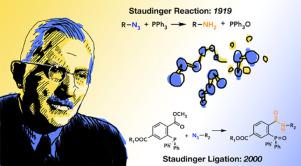Giant Pub Date : 2020-11-19 , DOI: 10.1016/j.giant.2020.100036 Virgil Percec , Qi Xiao

|
Hermann Staudinger was born in Worms, Germany on March 23, 1881 and studied chemistry at University of Halle, Technical University, Darmstadt and Ludwig Maximillian University, Munich. In 1903 when he was only 22 years old, he obtained his PhD in Chemistry with Daniel Vorlaender in Halle. He started his habilitation with J. Thiele at the University of Strasbourg where in 1905, at age 25 he reported the discovery of ketenes. In 1907 at age 26 he discovered the [2 + 2] cycloaddition of ketenes with imines. This reaction remains even today the method of choice for the synthesis of β-lactams the main building block of antibiotics. This reaction is known as the Staudinger synthesis. In 1907 he obtained his habilitation in Strasbourg and moved as a junior faculty to the Technical University in Karslruhe. In Karslruhe he became for the first time interested in polymers. In 1912 he moved as professor of organic chemistry at Swiss Federal Institute of Technology in Zurich (ETH Zurich) where in 1919 he discovered the reduction of azides with triphenylphosphine, known as the Staudinger reaction. In 1920, at age 39 and at the pick of his professional career as an organic chemist he published a paper claiming that natural and synthetic polymers are covalently linked macromolecules. He had no support for this concept. In 1953 he received Nobel Prize in chemistry “for his discoveries in the field of macromolecular chemistry.” As seen even from Nobel lecture, his ultimate dream was to bridge between synthetic macromolecules and biology. His dream came through in the year 2000 when Bertozzi, Raines and Kiessling discovered Staudinger ligation, a bioorthogonal reaction that allows chemistry in living systems. His dream did not come through by bridging between synthetic macromolecules and biology but by transforming Staudinger reaction into Staudinger ligation.
中文翻译:

从有机化学到化学生物学,通过大分子与Hermann Staudinger
赫尔曼·施陶丁格(Hermann Staudinger)于1881年3月23日出生于德国沃尔姆斯,曾在哈勒大学,达姆施塔特技术大学和慕尼黑路德维希·马克西米利安大学学习化学。1903年,年仅22岁的他在哈勒(Halle)的丹尼尔·沃兰德(Daniel Vorlaender)获得了化学博士学位。他在斯特拉斯堡大学的J. Thiele开始了适应训练,他于1905年在25岁时报道了发现烯酮的过程。1907年,他26岁时发现了烯酮与亚胺的[2 + 2]环加成反应。直到今天,该反应仍然是合成β-内酰胺(抗生素的主要组成部分)的首选方法。该反应被称为施陶丁格合成。1907年,他在斯特拉斯堡开始了自己的职业生涯,并以初级教授的身份转到卡尔斯鲁厄技术大学。在卡尔斯鲁厄,他第一次对聚合物感兴趣。1912年,他移居苏黎世瑞士联邦理工学院(ETH Zurich)担任有机化学教授,在那里他于1919年发现用三苯膦还原叠氮化物的方法,即史陶丁格反应。1920年,年仅39岁的他选择了有机化学家的职业生涯,发表了一篇论文,声称天然和合成聚合物是共价连接的大分子。他不支持这个概念。1953年,他获得了诺贝尔化学奖“ 在39岁时,在他作为有机化学家的职业生涯中,他发表了一篇论文,声称天然和合成聚合物是共价连接的大分子。他不支持这个概念。1953年,他获得了诺贝尔化学奖“ 在39岁时,在他作为有机化学家的职业生涯中,他发表了一篇论文,声称天然和合成聚合物是共价连接的大分子。他不支持这个概念。1953年,他获得了诺贝尔化学奖“表彰他在大分子化学领域的发现。” 从诺贝尔演讲中也可以看出,他的最终梦想是在合成大分子和生物学之间架起桥梁。他的梦想是在2000年实现的,当时Bertozzi,Raines和Kiessling发现了Staudinger结扎法,这种生物正交反应可以使生命系统发生化学反应。他的梦想不是通过在合成高分子与生物学之间架桥而实现的,而是通过将施陶丁格反应转化为施陶丁格结扎而实现的。



























 京公网安备 11010802027423号
京公网安备 11010802027423号